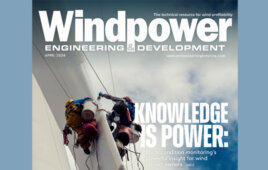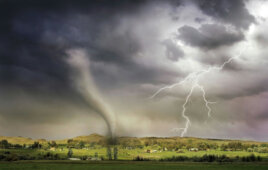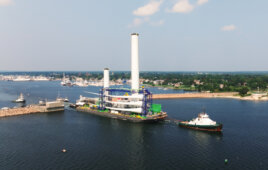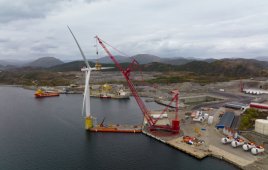The energy transition is driving the development of offshore wind power around the world to provide communities with reliable clean power and prevent harmful greenhouse gas (GHG) emissions from being released into the atmosphere.
In the United States, the development of offshore wind projects is more advanced on the East Coast due to the shallower water than on the West Coast. Wind resources are plentiful and water depths in the east drop off slowly, making the region optimal for the installation of wind turbines with fixed bottom foundations within 15 to 30 miles of shore. Fixed bottom foundations can be installed at water depths up to approximately 200 ft (~60 m).
Offshore wind leases were awarded on the West Coast at the end of 2022. However, the development of offshore wind off California is a more challenging task, as the water depth increases more rapidly than on the East Coast and the offshore lease areas are in water too deep for fixed-bottom foundations. Floating offshore wind turbines are the only feasible solution on the West Coast.
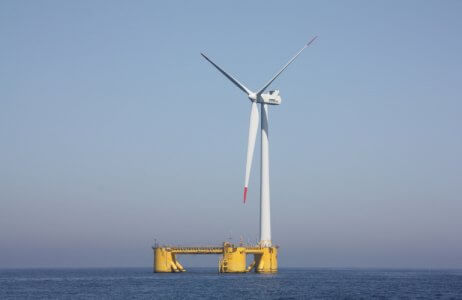
Windfloat Floating Offshore Foundation and Vestas V-80 2MW Offshore Wind Turbine, Povoa de Varzim, Portugal. (Photo by Senu Sirnivas / NREL)
Floating offshore wind power
Most offshore wind farms on the East Coast are planned for 15 to 30 miles from land because fixed turbine technology only allows for depths up to approximately 200 ft. On the West Coast, where water depths can reach to over 3,000 ft in some areas, floating turbines are needed.
The concept of floating offshore wind is fairly new – the world’s first floating wind turbine was installed off the coast of Italy in the mid-2000s. Whereas fixed turbines have foundations that either rest or are driven into the seabed, floating turbines are mounted on structures that float atop the water and are stabilized through anchors to the seabed.
One may ask: How would floating turbines function in waters that deep? Wouldn’t storms and massive waves affect power production? Luckily, the technology used to anchor floating turbines can withstand most conditions.
Floating offshore wind technology
There are a few key types of floating offshore wind technology in the market. The first is a mooring line stabilized platform. The mooring line stabilized platform functions with a tension leg platform by using mooring lines to anchor the turbine platform to the ocean floor. To put it more simply, it almost functions like a boat’s anchor. The mooring line stabilized platform was the technology used for the first floating wind turbine in Italy.
The second type of floating wind turbine is a ballast stabilized system. This system uses a spar buoy — a long cylindrical floating device — to maintain stability amid waves. Not unlike the tension leg platform, the spar buoy is tied to the seafloor using anchors. The spar buoy is submersed deeper in the water than other modes and can provide increased stability.
The third form of floating wind turbine is a buoyancy stabilized platform. Also known as a barge system, the buoyancy stabilized platform is comprised of a large ‘barge’ or pontoon base that floats mostly atop the water. The barge uses mooring lines and anchors to stabilize the turbine platform. New systems are triangular, and some conceptual designs have been developed to have two wind turbines on the platform.
There are a few different types of floating offshore wind turbines, and we can expect more developments in the future as the industry grows.
What are the barriers to widespread adoption?
While there is an optimistic future ahead for floating offshore wind, there are still several challenges that will need to be addressed before mass adoption and implementation.
- Environmental considerations: As with any energy project, environmental considerations also come into play for floating offshore wind farms. And there are a few concerns that must be addressed if we hope to see widespread adoption, including disruptions to the seafloor, protecting aquatic life and natural habitats and supporting the fishery industry and local communities.
- Cost: As with any new and emerging technology, cost is a primary factor to consider with floating offshore wind farms. The price of the installation needed for floating offshore wind technology is still currently higher than that of fixed turbines. We expect these costs to come down over time.
- Supply chain: One of the reasons for the higher cost of floating offshore wind materials is constraints in the supply chain. The supply chain was designed in a way that supports fixed turbines, but that is slowly changing over time. Furthermore, these turbines rely on precious minerals and metals that we will need to mine if we hope to expand the industry.
- Transmission: Dynamic cables are required to transmit power from the floating wind turbines until cables can be laid on the seabed. The dynamic cables are used in the oil and gas industry, but higher voltage (and power) cables are required to connect to offshore wind farms. Floating platforms for the offshore electrical substations would also be required to collect and transmit the power from the wind turbines and is being developed for these applications.
- Points of interconnection: One of the key challenges is finding points of interconnection onshore that can accommodate the large amounts of wind power and transmit it to the load centers. On the West Coast, most of the load centers are far from the offshore lease areas, and there are very few points of interconnection capable of handling large amounts of power located in close proximity to the shore. So, the transmission system needs to be built out to transmit the offshore wind power efficiently and reliably.
While there are still challenges facing the floating offshore wind industry, it is exciting to see experts from around the world come to together to solve them.
A future of floating wind farms
As we press forward with the energy transition, we should be looking at offshore wind power as a viable means of reducing emissions. The offshore wind industry has kicked off on the East Coast, with many leasing areas already in various stages of development. Fixed bottom turbines are a great solution in that region, but they won’t be feasible on the West Coast.
That’s why we’re excited to see upcoming developments in floating offshore wind farms to support decarbonization in the west. With the right technology and expertise involved, we should be able to produce bountiful renewable energy and reduce the amount of GHG emissions being released into our atmosphere.
Our teams at Stantec are well positioned to support owners and developers in optimizing all factors of offshore wind projects, including environmental, permitting, engineering, construction, commissioning, and operations. If you have any questions about floating offshore wind projects, please reach out to us.
Ralph Kurth is Senior Principal, Energy, for Stantec. With more than 35 years of experience, Ralph has worked on a range of power system projects. His focus is currently on HVDC transmission systems, AC substations and their automation systems. While his assignments are wide ranging and complex, his goal remains the same — to provide solid advice to project teams and clients.
Phaedra Taiarol is a Supervising Engineer for Stantec. With more than 20 years of experience in the high voltage power transmission industry, Phaedra has been involved with and led teams on projects that include high voltage direct current (HVDC) systems, high voltage cables, power system studies, and substation grounding studies and design.
Ivor Shaw is a civil engineer with over 42 years of experience in the energy and power sector in Canada, Ireland, and the US. He has been involved in the development, design, construction, rehabilitation, and commissioning of wind and hydro projects and applications to improve the client’s return on investment. He is a wind, hydro, and power delivery specialist with experience in planning, management, design, evaluation, project management, procurement and construction management.
Filed Under: Featured

